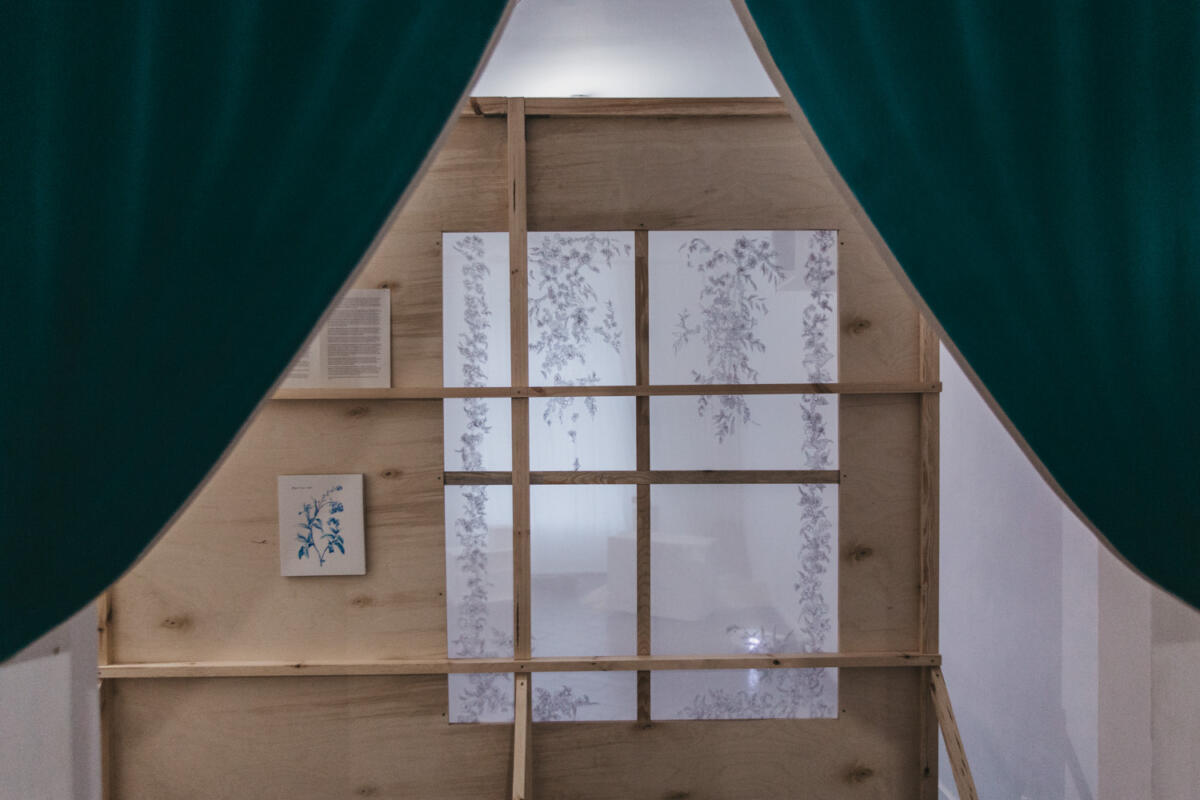
A year ago Wojciech Szymański had a first interview with me. I had said back then, that I love to read interviews with other artists. Yesterday, it came to my mind that I would like to read an interview with you but I couldn’t find any. Like I’ve mentioned before, I love reading conversations with artists. What about you?
I think interviews are a super nice way of talking about art. They are lighter than essays or scientific articles but you can read more unconventional things from them. This inconspicuousness charms me. By the way, it can be surprising for both the person asking the questions and the one responding too. I have never imagined myself as an interviewee but it will be interesting to prove oneself.
After your last exhibition, viewers can associate you with numerous representations of curtains, subtle colours and gradients. What’s the story behind your curtains? How did they start and where do they come from? Back when we were in the Academy together I remember your paintings featuring architectural structures and some kinds of palaces covered with screen-like elements.
I can say that this curtain motif came to me when I was working on my diploma exhibition in 2015. My starting point was using prints of old postcards with images of Silesian palaces which no longer exist. At the time I was fascinated by photography and its power of keeping memory and at the same time disguising it. That’s why I decided to cover and hide the palaces by putting geometrical boards on them. These boards serve as a cover and also a place where ideas could be projected.
In fact, I don’t really remember what attracted me to the palaces. I read the book, The Palace, by Wiesław Myśliwski – I think I had borrowed it from Radek Szlęzak. This book deals with the subject of memory. I had also come across the term The Palace of Memory(Pałac Pamięci). It is a mnemonic system. The idea is to take something which you want to remember and associate it with a certain place: a room, a landscape, a building. It could be an imaginary space or a real one. By creating these imaginary rooms and connecting them with the thing you want to remember, you can remember more. The third thing which attracted me to the palaces was an internet blog titled The Palaces that You Won’t See Anymore” where I found these postcards I had mentioned before. So all of that, plus the mentioned boards overlapped and brought the idea of palaces to me.

Emilia Kina, ‘Pałac II’, 2015
It turns out that photography had a huge impact on me, which may not be visible at first glance. So the story of my curtain is closely connected to photographic materials. By photographic materials I mean not only photographs but also studios, backdrops and camera obscura. I should also mention something about the theme of fabric in my painting. I mean not just painting as such, but also about the function of the fabric used to protect the painting from external factors or unwanted viewers. It is said that Courbet’s painting The Origin of the World was covered by a green velour and shown to very few people.
The progression to the newest paintings have developed slowly but systematically. In my case, there were no breakthroughs or sudden fascinations, but rather the development of already known motifs.
So maybe you can tell me something about studying at the Academy of Fine Arts in Kraków. Did you like it or were you rather relieved to have finished?
Looking back at it now, it feels like a good memory but I wouldn’t want to go back. I think what inspired me to create was the exchange of experiences between students. For me the first two years were hard. After art high school, the first year at the Academy was a return to painting still lifes and figures. It was hard for me to “think on my own”. I think the third year was important to me. I chose copperplate and photography as my studio of choice. I was in the photography studio until the end of my studies and did a photography supplement to my diploma. I think that working with Tomáš Agat Blonski and Szymon Nowak gave me the most. I also have very good memories of Michal Zawada, who was my reviewer.
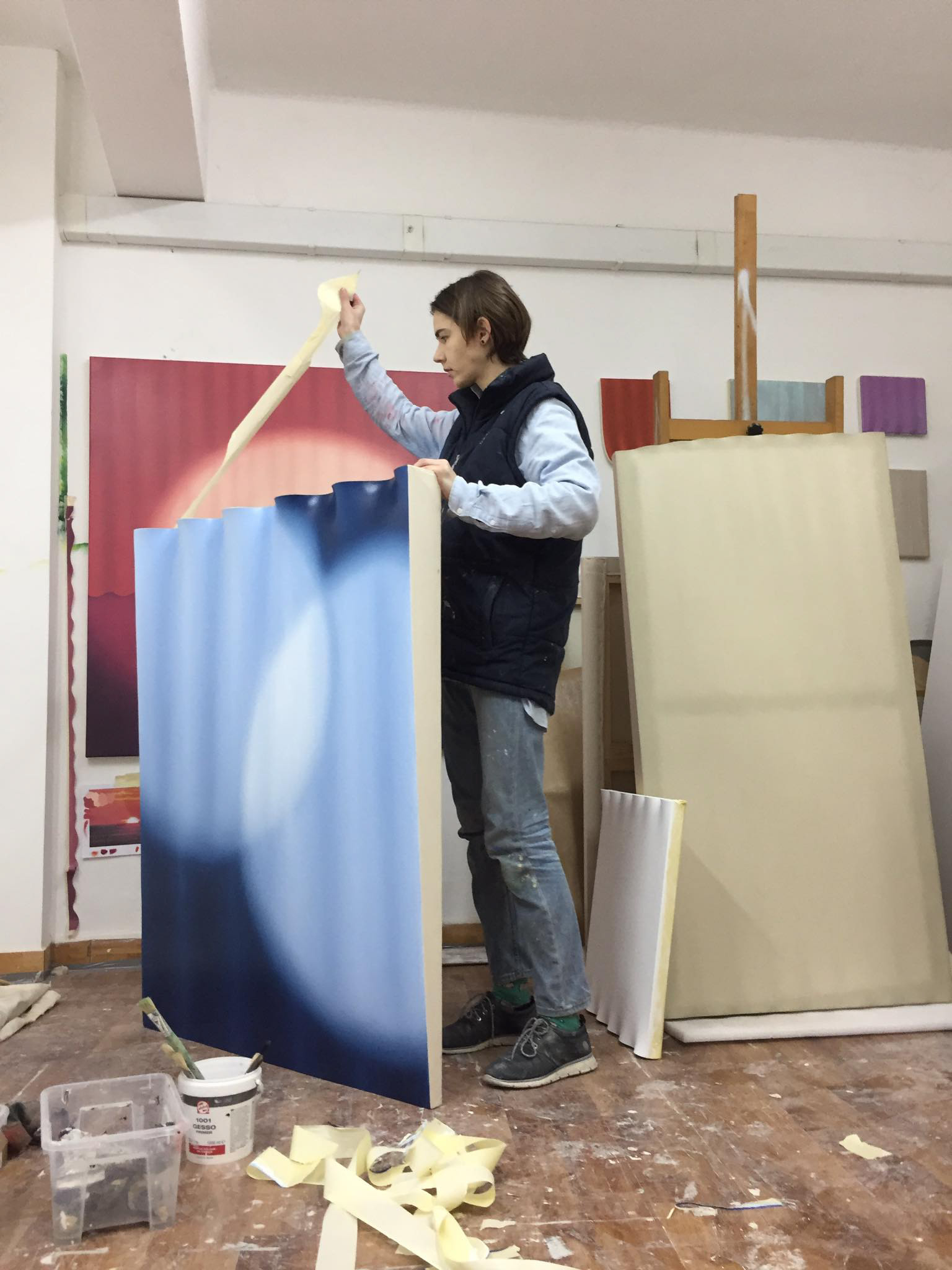
Emilia Kina in her studio
It was always interesting for me that after you graduated you had to start working. Despite this, you were always engaged in art. Lots of our friends had similar experiences, but because of their daily work, I can imagine it’s easy to forget about art completely.
Yes, shortly after finishing Academy I started working. While looking for a job, the most important thing was to find something with flexible working hours, not full time and as a bonus, connected to art. This way I found a job in Bunkier Sztuki in Krakow as an exhibition supervisor. At that art institution I also had the chance to work in their education section where I could prepare my own workshops mainly for children and teenagers. I think it was a super nice experience for me because I could see how it looks from the inside. I took part in exhibition disassemblies and other technical operations at their public art gallery. In the meantime I got a job at a community centre where I’m actually still working at the moment. I ran their workshops with children and adults. I am writing in the past tense because unfortunately, the pandemic forced us to stop our activities. Currently, I work at a small bakery/cafe. What all these jobs have in common is that they are super flexible. I receive a lot of support from my co-workers, so it has always been possible for me to take time off for art activities such as shows. I think my job somehow organizes my week, and I find it easier to make my schedule.
An important reason why I continued doing art despite working was the studio I shared with my friends, Justyna Smoleń, Filip Rybkowski and Radek Szlęzak. They were there working all the time, so this somehow kept persuading me. It was at Telpod where we were based at the beginning.
You developed and changed a lot after your studies. At first, you had slightly covered palaces in your paintings, then you eliminated elements, experimented with the technical side and focused on layers, images and different material. Now there is only the curtain left, which was previously a piece of a larger puzzle. Maybe you are moving towards simplification, to some form of abstraction?
I think that this is a correct observation and that the road to simplification is visible. It seems to me that I operate with a simple form even though I sometimes interfere quite strongly with the shape of the canvas. In the shape itself I try to simplify the form. It is rather a scheme than an identical reproduction of the curtain’s shape. The same happens when I paint, I also do it synthetically. These are simplified parallel lines in some set rhythm. Although my works are strongly based on the form/shape itself and it can be associated somehow with abstraction through their synthesis. On the other hand, the works themselves are strongly representational. I mean that they are somehow a fragment of reality. I wouldn’t say about myself that I’m an abstract painter. I think that the fact that I don’t paint figuratively, doesn’t classify me as an abstractionist. I often use very specific images and I also create using different media so, in fact, it would be rather hard for me to call myself an abstractionist. However, some of my works, taken out of the context of the rest of my work, could probably be classified as abstract art.
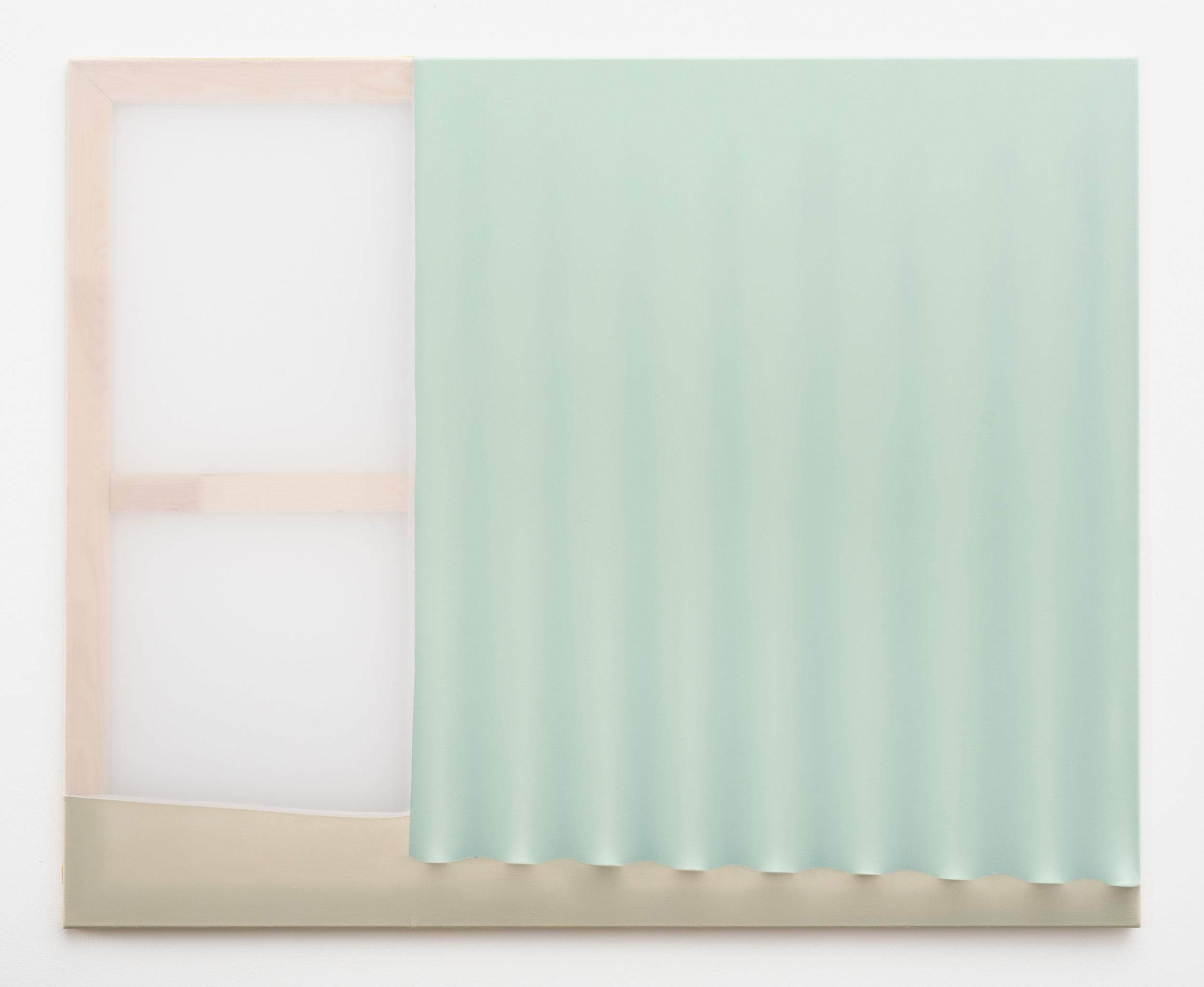
Emilia Kina, ‘untitled’, 2020, fot. dzięki uprzejmości Galerii Raster
How do you find yourself among other female artists? I am often asked about my approach to feminist art and my place within it. In my context, this question is quite obvious and banal because I am a figurative painter, often depicting the story of female characters. However, in your paintings, there are no figures. Some of your paintings can be described as abstract. Still, it seems to me that they have a very strong feminine atmosphere, they are very sensual.
Yes, I agree that it’s not obvious and in fact, I’ve recently been thinking about it. I think there is this theme in my work and not only in the sensuality itself that you mentioned. Maybe it is not obvious but in my earlier works, I referred to the history of women. I mean a painting by Courbet that I’ve mentioned before – The Origin of the World. It was considered a pornographic painting and remained covered by green velour. This piece inspired me to explore the motive of peeping. This is how I created works on paper and paintings inspired by old engravings, depicting scenes of peeping in an alcove. That way I also created a paravan, which was exhibited in Raster Gallery. I used a cropped graphic by Albreht Durer and engraved it on the paravan. The screen shows a posing model who stares at the viewer. Unlike Durer’s work, here the woman is not being watched, but she is the one doing the watching. I should also mention the exhibition Déjà vu, which I did with Filip Rybkowski and Michał Zawada who was the curator. While working on that exhibition I was inspired by the figure of Mollie Fancher also known as Enigma from Brooklyn. The figure of St. Lucia appeared in my work as well. There are lots of women’s stories in my art, although they are not always visible at first glance.
Well, that’s interesting, I didn’t know that. So maybe you can tell me about 2020. According to my observations, it is hard for you to hide when something is bothering you. The past year has been emotionally intense, upsetting and disturbing. On the other hand, you also had some super positive moments like a great solo exhibition in Raster Gallery. How has 2020 affected you and your work?
Oh no! I thought I am good at this. The events of 2020 had an impact on my actions or rather lack of them. I’ll admit that I did very little during that time. It’s not like, as I’m sure you know, when there are problems with pandemics, laws being broken, and so on, artists lock themselves in their studios and work – completely detached from reality. If anyone can do that, then I am envious. In fact, my activities were like a sinusoid, either I did nothing or everything at once. Despite all the political and social confusion, 2020 started well for me. In March, I opened my solo exhibition Parawan in Raster. A new beginning for me was also a change of studio. Although it happened at the worst time, before the announcement of the lockdown, but still it was a fresh place, giving new energy.
Back to the point, did 2020 directly affect my work? Perhaps strong colours have shown up. I also think the image of an empty stage, covered by a heavy curtain and lit by spotlights apparently announced some sort of action. It seems to be symptomatic.
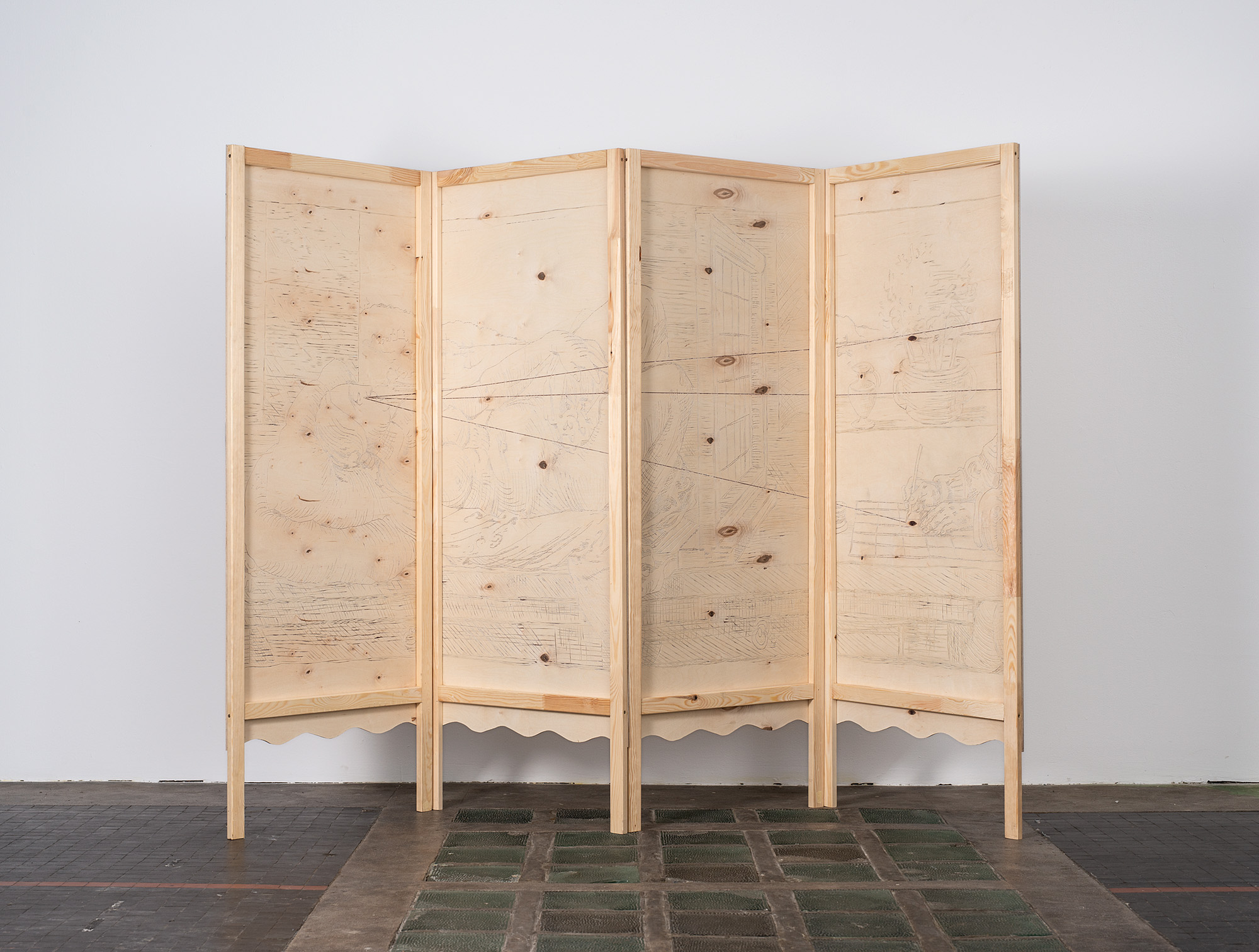
Emilia Kina, ‘Parawan’, photo courtesy of Raster Gallery
Well, yes, I am doing sleeping paintings – that’s how characters from my paintings try to survive all this mess. You have the spotlight, the great expectations of re-entering the scene, waiting for some kind of action. I just wonder if the world will return to the rhythm we have known.
All right, let’s move on to nicer things. I know that you are a connoisseur of jewellery, you have an eye for finding minimalist earrings and you even took a course in jewellery making. I associate earrings with small sculptural forms. It seems consistent to me because your work is often three dimensional. I imagine you could create large-scale sculptures someday. I also wanted to use the word “elegance” somewhere here – which in the context of your work seems important to me, and we all know that earrings mean elegance. What is your attitude towards the painting medium, is painting the only right choice for you, or one of the possible solutions?
It seems to me that I am taking small steps towards going three dimensional with my art. Anyway, for now, I can’t imagine I will make sculptures. I classify my paintings as something on the border between paintings and objects, although they are closer to paintings. It’s intriguing to me that I can relate to a painting that sometimes imitates itself, I mean the fabric itself on which I paint. Perhaps my work is most associated with the classic paintings on canvas, but I have also done fabrics, needleworks, objects and photography. I would not say that painting is the only right form for me, but maybe the closest one.
Jewelry, for some time, is my fascination and a small addiction. As you mentioned I took a course in making jewellery. This wonderful gift I got from Filip for my 30th birthday. It was a very interesting experience and I would love to do it again. I learned a lot, I made earrings and a ring for myself. I was also impressed by the repoussé technique. Unfortunately, we didn’t have enough time for that. However, I have repoussé tar, waiting in the studio, so I think I will work with it. I may create some form of sculpture using this technique, but rather in the form of relief.

Emilia Kina & Filip Rybkowski, ‘Innocent Eyes, Weak Arm’, Šopa Gallery in Košice, photo: Tatiana Takacova
I envy you how well your works are made. I never see any technical failures, apart from the fact that I consider your paintings to be very successful on all levels, the technical layer is extremely impressive. Tell us something about the technical process, or about your creative process in general, from the beginning to the end. How you come up with ideas and then how it is done.
I pay a lot of attention to the realization. In my works, which are delicate and flat-painted, this technical side is very important because every imperfection is visible and distracts from the work itself.
I used to start with a pencil sketch, now all I need is a general drawing and contrasts. In the beginning, I used to do sketches with technical details like dimensions and cross-sections, but now I don’t need that anymore. As you know I make the frames for paintings by myself, so this process takes me the most time. Anyway, I like it very much. In my first painting with a formed loom/wave my Dad helped me, he showed me what and how to do. Now I’m perfecting the technique on my own and I’m choosing the tools that work best for me. The next step is to draw the shape, cut and polish the edges, attach it to the loom and mark the gaps with putty or pieces of wood if it’s needed. This is a time-consuming process because everything has to dry well before I can proceed. Stretching the canvas is already halfway, here there is always the problem of choosing the cotton canvas, which must be flexible. Then, you know, glueing, priming and painting. The painting itself goes quite fast. I paint wet to wet so I have limited time to finish the job. I also have the colours I want to use, prepared in larger amounts.
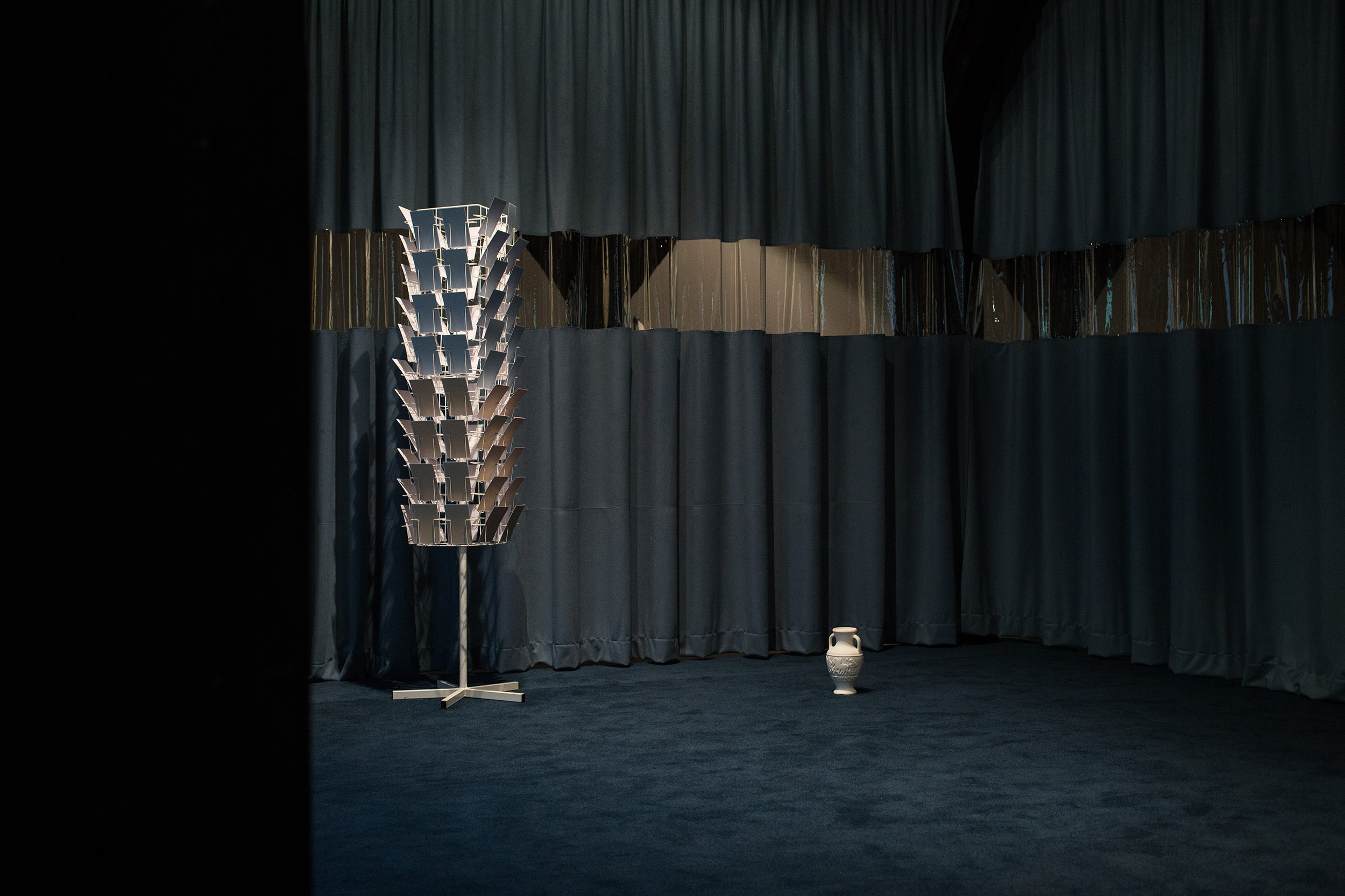
Emilia Kina & Filip Rybkowski, ‘Mirage Travel’, Wozownia Art Gallery in Toruń
Until recently, you often showed your works in duet with Filip Rybkowski. A wider audience got to know you at the exhibition in Henryk Gallery in Krakow, ŠOPA in Kosice or in Wozownia in Torun. These shows always strongly arranged gallery space. You and Filip entered into very interesting dialogues. How do you feel working alone? Are you an introvert contemplating work in solitude or maybe you miss collective work?
We did together with Filip four shows together. It started with Déjà vu in the no longer existing Henryk Gallery in Krakow. For this project, we worked with Michał Zawada as a curator. It was a project we had been thinking about for a very long time, and Michał helped us to make it into a coherent whole by adding new aspects. Filip was the catalyst of this project. He came out with an idea and somehow it happened. Our cooperation made me realize that I feel good at arranging space, which I never expected. We created a whole scenography that was coherent with the exhibition theme. At other exhibitions, we often started from a space that in a way suggested a theme. I think the biggest challenge was the exhibition in the Wozownia in Toruń, Mirage Travel. We had planned it for the small space of the archive, but by accident, we ended up with a huge space with wooden columns. It was a big challenge, but I think we managed it very well with the support of Natalia Cieślak who was our curator.
Coming back to your question – do I prefer to work alone or in a collective? I don’t have a clear answer. When I think about working in the studio, even though I share it with Filip, I can turn it off and I like to work in silence. I’m an introvert in my everyday studio life, but I miss and need to work in a collective from time to time. It forces me to work differently. Working with Filip is very inspiring for me. At each of these exhibitions, I reached for a different medium, not only painting. It is very developing for me. I hope that we will do something else together soon.
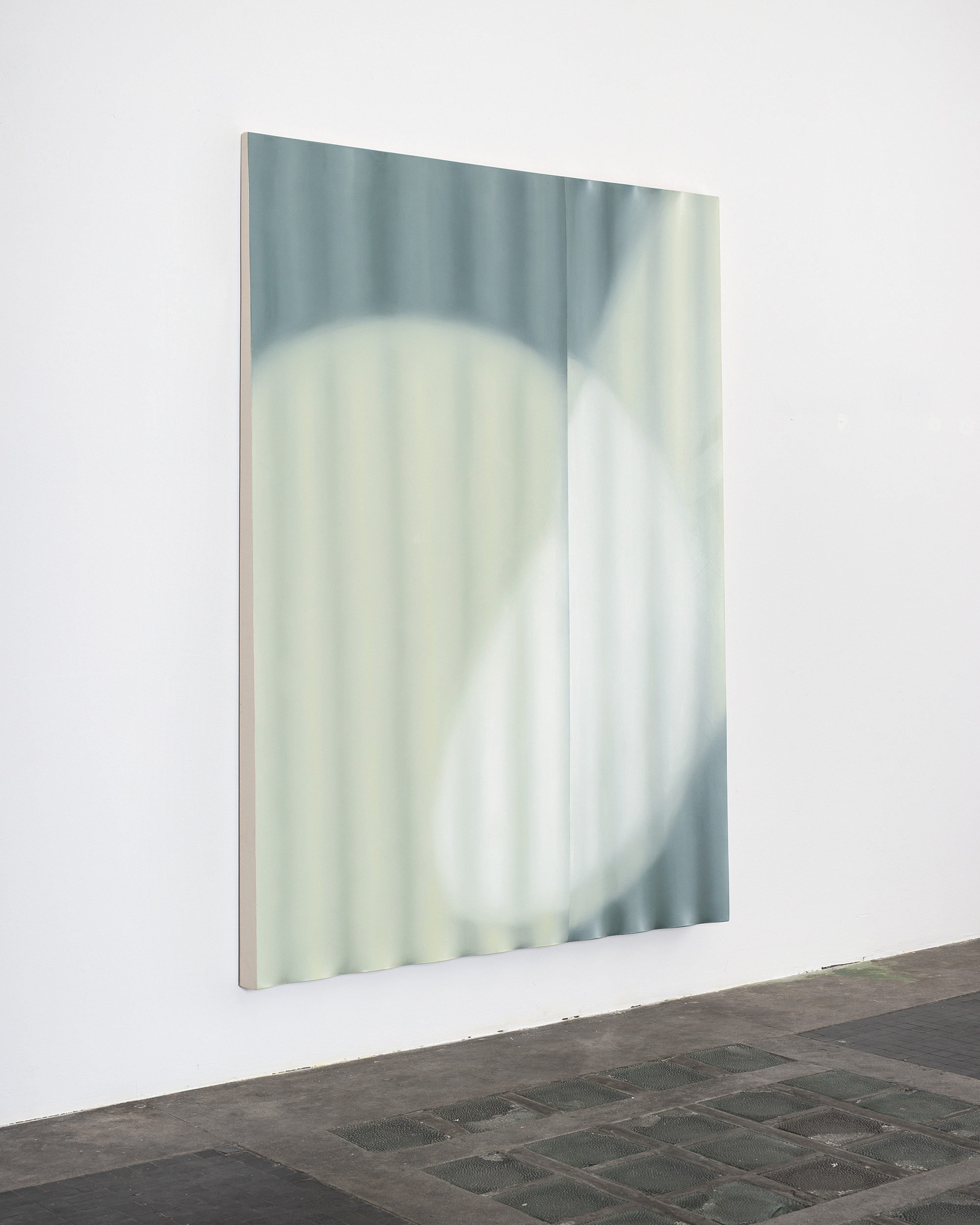
Emilia Kina, ‘spotlight’, 2020, photo courtesy of Raster Gallery
You said about the technical process of making art. Tell me please, what it looks like even before you get down to cutting, glueing, nailing, stretching. What does your way to the painting look like? Where do you look for inspiration, are there any artists that are particularly important to you?
It’s hard to describe it one way. Sometimes I read and watch more fiction, documentaries, or strictly theoretical books. That’s when I usually make notes or highlight the fragments that are interesting for me. Then I go back to old notes, sketchbooks with abandoned ideas. I try to be sensitive to small inspirations that can appear anywhere. I also have a folder on my computer with pictures that catch my attention and I go back to them from time to time, analyze and print them out. Coming back to books, I will mention one of Jane Goodall’s, “Seeds of Hope: Wisdom and Wonder from the World of Plants”, in which I would not expect to find something to use for myself. During the reading, I came across a fragment about Victorian flower language, an amazing form of communication through gifting someone with specific flowers in a specific arrangement. That’s when the forget-me-not piece came about.
When it comes to artists, I return with great sentiment to the works of René Magritte or Gerhard Richter. I appreciate the work of Issy Wood, Henni Alftan or photographer Dirk Braeckman. I also return often to old art, especially to trompe l’oeil painting.
Tell us what your plans are for the near future if anything can be planned now.
Yes, it’s hard to plan anything at the moment, it’s very blurry, just postponed to an unknown future. I do have a few starting points, not all of them confirmed yet, so I’m not fixated on the idea that everything will work out. Because of that, I won’t mention them here. I dream of doing a solo exhibition. I think I can reveal that it will be in collaboration with Agata Biskup. We have already taken small steps and talks. I really hope it will come to life soon.
I am currently working on a series called Spotlight, which is inspired by heavy stage curtains. I think it is the light/spotlight that brings narratives to the works. I am also starting another series, which somehow started from Spotlight, of sunrises and sunsets that will be a combination of stage space and landscape. I imagine these will be large works and not necessarily going out into space. I am also working on a series of works inspired by traditional Japanese curtains – noren. All three of these series will be somehow associated with the light/sun motif.
